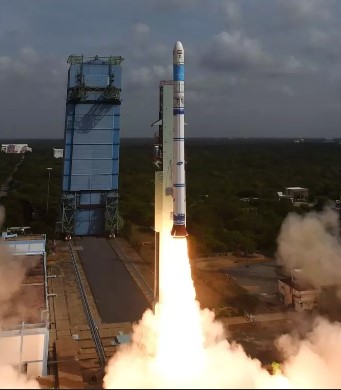India has achieved a significant milestone in its space journey with the successful launch of its Earth observation satellite, EOS-08, aboard the SSLV-D3 rocket. This event took place on Friday, as the Indian Space Research Organisation (ISRO) marked the final developmental flight of the Small Satellite Launch Vehicle (SSLV)-D3. The launch was an important moment for India’s space program, showcasing the country’s advancements in satellite technology and launch capabilities.
The Launch of SSLV-D3
The SSLV-D3 rocket took off from the Satish Dhawan Space Centre, located in southern India, at 9:17 a.m. local time (0347 GMT). This launch was the third developmental flight of the SSLV, which ISRO announced was a complete success. The SSLV, designed to be a cost-effective and flexible launch option, has been developed to place small satellites into low Earth orbit.
After a smooth flight, the rocket successfully placed the EOS-08 satellite into its intended orbit. This achievement marks the successful completion of ISRO’s SSLV Development Project, a significant step forward for India’s space exploration efforts. The success of SSLV-D3 not only demonstrates the capability of the rocket but also opens up new possibilities for launching small satellites efficiently.
EOS-08 and Its Purpose
The EOS-08 satellite, which was aboard the SSLV-D3, carries three important payloads designed for various applications. The SiC UV Dosimeter, the Global Navigation Satellite System-Reflectometry payload (GNSS-R), and the Electro-Optical Infrared Payload (EOIR) are some of these payloads.
The EOIR payload is particularly versatile, designed for applications such as satellite-based surveillance, disaster monitoring, environmental observation, and even industrial and power plant disaster monitoring. This technology will help monitor natural disasters like floods, forest fires, and volcanic eruptions from space, providing critical data to manage and respond to such events effectively.
The GNSS-R payload has a unique purpose. It demonstrates the use of GNSS-R-based remote sensing, which can be applied to analyze ocean surface winds, assess soil moisture levels, study the cryosphere (areas of the Earth where water is in solid form, it can be detected in inland water bodies and glaciers and ice sheets. This technology is particularly useful for understanding environmental conditions and changes, especially in regions like the Himalayas, where monitoring is challenging.
The SiC UV Dosimeter is another important payload on EOS-08. It is designed to monitor UV radiation levels, particularly in the viewport of the Crew Module in India’s upcoming Gaganyaan mission. This mission will be India’s first manned space mission, making the SiC UV Dosimeter an essential component in ensuring the safety of astronauts by acting as a high-dose alarm sensor for gamma radiation.
Significance of the SSLV-D3 Mission
The successful launch of the SSLV-D3 and the precise placement of EOS-08 into its orbit are important achievements for ISRO. This mission not only showcases the SSLV’s capabilities but also the advancements India has made in the design and launch of cutting-edge satellites. The SSLV is an important contribution to India’s space program since it is intended to be a versatile and affordable choice for launching small satellites.
The SSLV-D3 mission represents the culmination of ISRO’s efforts to develop a reliable launch vehicle for small satellites. With this success, India is poised to enhance its capabilities in Earth observation, disaster management, environmental monitoring, and other critical areas. The data provided by EOS-08 will be instrumental in supporting various applications that contribute to the well-being and safety of people, as well as the protection of the environment.
India’s successful launch of the EOS-08 satellite aboard the SSLV-D3 rocket marks a significant milestone in the country’s space program. With the successful deployment of this satellite, ISRO has demonstrated its ability to develop and launch advanced space technologies that have far-reaching benefits. The EOS-08 satellite, with its diverse payloads, will play a crucial role in various applications, helping to monitor and manage natural disasters, study environmental changes, and support India’s future space missions. This mission showcases India’s growing expertise in space exploration and its commitment to advancing technology for the betterment of society.




